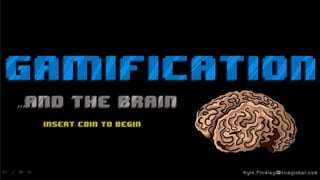Editor's Notes
- #5: Examples of such mechanics might include: Achievement: People like to win and have a feeling of control or mastery over their actions. This is a very basic human drive that can be harnessedCommunal Discovery: “wherein an entire community is rallied to work together to solve a riddle, a problem or a challenge. Immensely viral and very fun.” [Priebatsch, 2010]Appointment dynamic: “A dynamic in which to succeed, one must return at a predefined time to take some action.” e.g. happy hour at your local pub [Priebatsch, 2010]
- #6: Video gamesIt is important to make the distinction upfront between what we traditionally mean by “games” (e.g. video games, board games, party games, etc.) and a “gamified” experience. Gamification does not entail the turning of a traditionally serious experience (such as filling out your tax return or a research survey) into a gaudy, frivolous entertainment experience. An experience does not need to look overtly like a game in order to be compelling and engaging. For example, Facebook is probably the most successful non-game game ever invented. It has implemented game mechanics and reward structures that keep a large portion of the world’s population coming back several times a day. Yet, Facebook has no mascot, complimentary colours, traditional level structures or anything else that we would usually associate with a game.
- #9: Badgification/pointsificationWe also don’t mean the simple addition of badges, points and bright colours – the mere inclusion of these things does not automatically make an experience fun and engaging. This type of shallow design is sometimes pejoratively referred to as “badgification” or “pointsification”.
- #10: Badgification/pointsificationWe also don’t mean the simple addition of badges, points and bright colours – the mere inclusion of these things does not automatically make an experience fun and engaging. This type of shallow design is sometimes pejoratively referred to as “badgification” or “pointsification”.
- #19: Rewards for effort (i.e. positive reinforcement) trigger releases of feel-good chemicals in our brain, which train us towards desired behaviour. For example, Foursquare rewards users with badges for checking in the most times at a specific venue (mayor badge).
- #20: Rewards for effort (i.e. positive reinforcement) trigger releases of feel-good chemicals in our brain, which train us towards desired behaviour. For example, Foursquare rewards users with badges for checking in the most times at a specific venue (mayor badge).
- #21: RewardsEffective rewards cost designers relatively little but are highly valued by users. Less effective rewards cost designers more for the same level of user valuation as a more effective reward. Reward types are listed below in order of decreasing effectiveness [CNET, 2010]:Status is probably the most effective reward. It costs designers next to nothing and is highly valued by users as it taps into our social natures. Zicherman [2010] suggests that status has replaced material rewards such as cash, and that the less status rewards a game doles out, the more material rewards it needs to hand out to keep users engaged.Access to restricted features, options and areas e.g. VIP room in a nightclub or member-only analytics on a website.Power is an effective incentive for some e.g. community moderators that can ban users, remove status or shift points around; voting to change contents of front page of a website; etc.Stuff, both material (e.g. cash prizes) and virtual (e.g. game weapons or FarmVille seeds). Material stuff is costly to provide, whereas virtual goods are often free.According to Day, “you can sculpt [a] psychological reward-scape to some degree, but ultimately the best rewards are the ones in the minds of your players”.































































